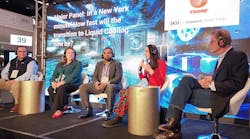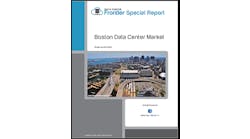Facebook is deploying a new cooling system in some of its data centers, which will allow it to deploy its cloud campuses in new places, the company said today. The new system, known as StatePoint liquid cooling system (SPLC), was developed in partnership with cooling specialist Nortek Inc., and uses an approach to evaporative cooling that is new to the data center industry.
“The SPLC system will allow us to consider data centers in locations which we could not have considered before, and make our network of data centers more energy- and water-efficient overall,” said Veerendra Mulay, a thermal engineer at Facebook, in a blog post announcing the new system.
The new system will use far less water than other indirect cooling technologies, addressing growing concerns about the use of water by hyperscale data centers, and their potential impact upon the local water resources and the environment.
In most of its data centers, Facebook uses direct cooling, bringing filtered outside air into the data hall and circulating it through racks to remove the heat generated by servers and storage units. SPLC takes a different approach, using the outside air temperature to produce cool water, which can then be used in cooling systems. Facebook is currently using the water in a cooling coil, which cools air that flows through the racks to cool servers.
Because the SPLC system produces cool water, it could be useful if Facebook decides to adopt liquid cooling for high-density workloads, as Google recently has done. The SPLC system can work with several types of liquid cooling deployments.
How SPLC Cooling Works
For now, Facebook says it can use the SPLC system to deploy data centers in places where it previously hasn’t, including locations with high heat and humidity, increased levels of dust and other air contaminants. This type of system could be useful in Asia and other humid climates, where data centers often operate slightly less efficiently due to the use of more power-intensive cooling and dehumidification systems.
Notably, Facebook has not deployed any data centers in Asia. It has three international data centers, all in European countries with cool climates (Sweden, Ireland and Denmark).
“Based on our testing in several different locations, we anticipate the SPLC system can reduce water usage by more than 20 percent for data centers in hot and humid climates and by almost 90 percent in cooler climates, in comparison with previous indirect cooling systems,” Mulay writes. “The system will not only protect our servers and buildings from environmental factors, but also eliminate the need for mechanical cooling in a wider range of climate conditions and provide additional flexibility for data center design, requiring less square footage to cool effectively.”
SPLC is an evaporative cooling system that leveraging Nortek’s experience with membrane energy exchanges. The system, which has been patented by Nortek, uses a liquid-to-air energy exchanger, in which water is cooled as it evaporates through a membrane separation layer. This cold water is then used to cool the air inside the data center
A diagram of how the SPLC system designed by Nortek uses membranes in evaporative cooling. (Image: Facebook)
The membrane heat exchanger is significant because it produces cleaner output of both air and water, eliminating the need to filter air or eliminate impurities from water – along with any energy used by those processes.
The membrane layer prevents cross-contamination between the water and air streams, Mulay says, keeping the water circuit clean and reducing maintenance. The membrane is also highly
resilient to scale formation and poor water quality, thereby extending the system’s operational life.
The StatePoint technology has been used in cooling systems for in hospitals, schools, warehouses and greenhouses, using liquid desiccant as the working fluid. Facebook worked with Nortek to develop the system targeting data center application which uses water as working fluid.
Multi-Mode Operation
The system operates in three different modes to optimize water and power consumption, depending on outside temperature and humidity levels. When outside air temperatures are low,
the SPLC’s most energy- and water-efficient mode uses that air to produce cold water.
- When outside air temperatures rise, the SPLC system will operate in an adiabatic mode, in which the system engages the heat exchanger to cool the warm outside air before it goes into the recovery coil to produce cold water.
- In hot and humid weather, the SPLC will operate in superevaporative mode, where outside air is cooled by a pre-cooling coil and then used to produce
cold water. - In cooler climates, the SPLC system will operate mostly in its most-efficient mode, while in hot and humid climates, it will typically operate in super-evaporative mode.
Facebook says that even when operating in adiabatic or super-evaporative mode, the SPLC is still more water- and energy-efficient than other indirect cooling systems.
“The key to high efficiency is maximizing the heat transfer systemwide,” Facebook said. “In Economizer mode, lower approach temperatures in the coils helps lower the fan energy. When the membrane exchanger is in use, it can cool the outside air as it does in Adiabatic mode but also cools the water in super-evap mode. This cold water (or ‘warmer water’) further contributes to efficiency gains.”
Here’s a diagram of the system design and airflow in an implementation used by Facebook:
The schematic above demonstrates the SPLC cooling scheme for a data center. The SPLC units
are deployed on the rooftop. These SPLC units produce cold water, which is then supplied to the
Fan Coil Wall (FCW) unit. These FCW units use the cold water supplied by the SPLC units to
cool the servers. The hot water from these FCW units is returned to SPLC units, where it will be
cooled and recycled through the system. (Image: Facebook)
Nortek Air Solutions is a custom HVAC specialist that has worked with many prominent companies in the data center industry. Facebook and Nortek began testing the SPLC approach in 2015.
“It’s time for data centers to highly consider alternative technologies that will protect our environment,” said Buddy Doll, President, Nortek Air Solutions. “This is why we are thrilled to work with Facebook, who has been a leader in developing innovative data centers around the world.”
Facebook says it will continue to use direct cooling in many data centers, as it continues to be the most efficient cooling technology in most climates.
As it continues its relentless expansion of its data center infrastructure, the SPLC gives Facebook a new tool to operate efficiently in humid climates (like Singapore, an increasingly significant data center hub). It also lays the groundwork for Facebook to investigate a larger shift to liquid cooling technologies, which are seeing increased adoption in high performance computing, a segemtn of computing which is expanding due to the growing use of compute-intensive AI installations.
“We continue to investigate various technologies including liquid cooling so that we are ready when the need arises,” Facebook said. “The SPLC system has the flexibility to be connected to various cooling delivery systems such as chip cooling and rear-door heat exchangers. There is a possibility we will use SPLC for these functions, but it will depend on our needs at each specific location. As our designs evolve, we will deploy the cooling solutions that would result in high efficiency (energy and water) while maintaining the necessary reliability.”






